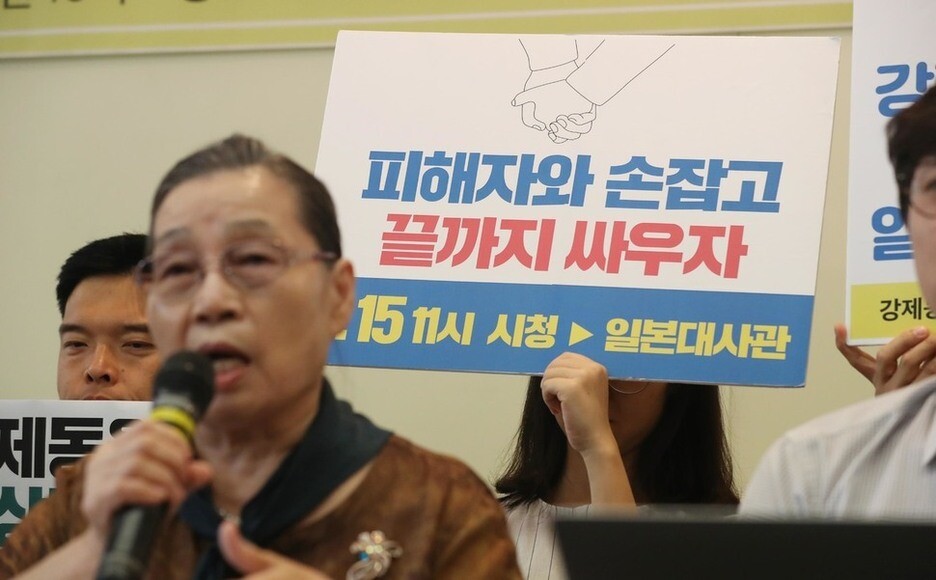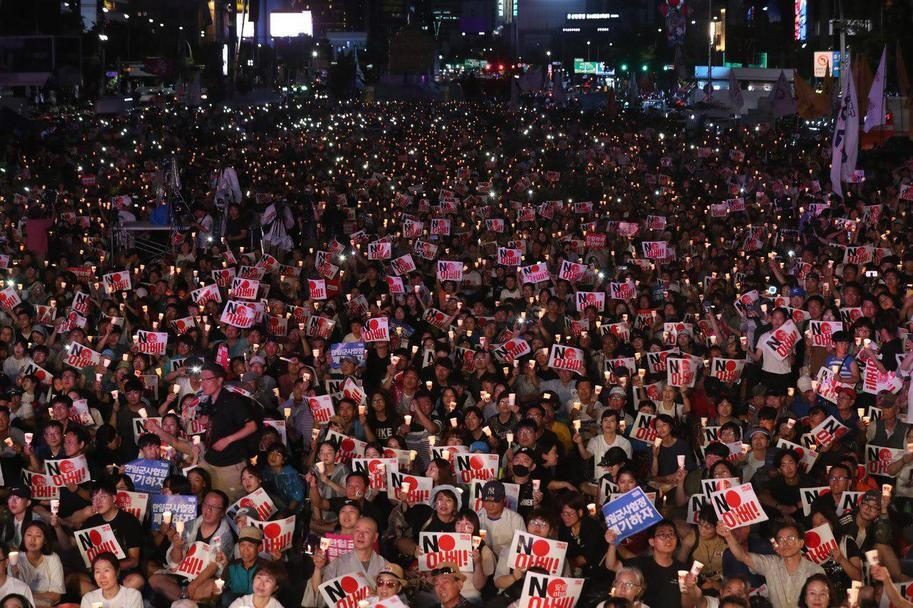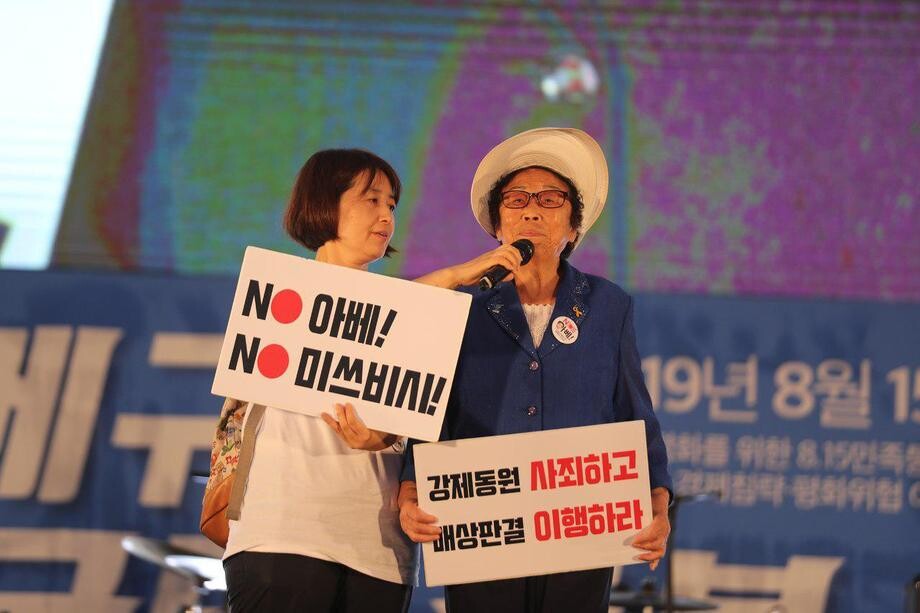hankyoreh
Links to other country sites 다른 나라 사이트 링크
S. Korean activist fights to have his father removed from Yasukuni Shrine

In February 1944, Lee Hui-ja (today 76 years old) was living with his family on Gangwha Island when his father was press-ganged by the Japanese military. Lee had just turned one year old. Before departing, Lee’s father promised the family that he’d come back soon, but they never heard from him again, even after Korea’s liberation from Japan’s colonial occupation. After joining the Association for the Pacific War Victims, Lee spent years searching for traces of his father and finally learned of his final resting place in 1997 — Japan’s controversial Yasukuni Shrine.
Lee’s spirit tablet had been enshrined there, after he was killed in battle during the War in the Pacific. Lee was infuriated to learn that his father, after being forced to join the Japanese military against his will, was receiving religious honors as if he’d laid down his life for the Japanese emperor.
Now, 23 later, Lee is co-president of the Council for Securing Compensation for Pacific War Victims, where he is working to restore the reputations of drafted Koreans who were laid to rest at Yasukuni.
At 2 pm on Aug. 15, the documentary “Annyeong, Sayonara” was screened at the Museum of Japanese Colonial History in Korea, in Seoul’s Yongsan District. The documentary is about the lawsuit that Lee filed to remove his father’s spirit tablet from Yasukuni Shrine. Some 20 people had come to the museum to attend the screening, which fell on Liberation Day.
As the star of the documentary, Lee himself was present, along with Hideki Yano, 69, a Japanese activist and the secretary-general of a group called Joint Action to Resolve the Issue of Compulsory Mobilization and to Settle Japan and Korea’s Historical Disputes. Lee and Yano were there to talk with the visitors.
Along with Lee’s lawsuit, “Annyeong, Sayonara” also presents the stories of other victims of compulsory mobilization. In 2001, 2003, and 2013, these individuals filed lawsuits at Japanese courts against the Japanese government and Yasukuni Shrine, calling for the end of the practice of unauthorized enshrinement. Out of concern that their lawsuit might be mistaken for a cash grab, they asked for only 1 yen in damages. But time and time again, the courts either ruled against them or threw out their lawsuits altogether. In their decisions, the Japanese courts argued that the government had no authority to meddle in a “religious facility,” namely Yasukuni.

During the conversation with audience members, Lee remarked that Japan was relying on contrived logic to allow the shrine to keep the remains and that it hadn’t apologized for the issue of compulsory mobilization either. “But that’s all the more reason not to give up,” he stressed.
“Tens of thousands of Korean young people who were dragged off to war are honored at the shrine for supposedly giving up their lives for the Japanese emperor. Even some people who survived the war are enshrined there,” he said.
Lee also mentioned lawsuits about forced labor at Nippon Steel and Mitsubishi Heavy Industries, which ended last year with the South Korean Supreme Court ruling favoring the plaintiffs. Even if Japan refuses to acknowledge its wrongdoing, Lee stressed, “We have to keep going if we want to win.”
“Older men who were victims of compulsory mobilization told us they could never give up, because Japan was waiting for them either give up or die. We have to carry on the fight on their behalf. Japan’s recent economic retaliation should be treated as a blessing in disguise.”
Help from conscientious citizens in Japan
Lee said that help from conscientious citizens in Japan had given him the strength to carry on his legal struggle. “If Japanese people hadn’t helped us out with our court cases, I guess we would’ve just called it a day. We were so grateful for their unflagging assistance that we had no excuse for getting worn out. It doesn’t feel lonely when you have a lot people with you,” he said.
Yano compared the alliance between the Korean victims and Japanese activists, and their long struggle against the corporations, to a David-and-Goliath story. “For nearly 30 years now, little people without any power have been taking the fight to corporate juggernauts like Mitsubishi. Shuttling back and forth between Japan and South Korea for multiple trials has been exhausting, but in the end, we scored a victory in the courts last year,” Yano said.
Yano also brought up Japan’s economic retaliation. “Japan is taking these retaliatory measures out of a feeling of fear and anxiety. While this is a difficult situation, I think that, if the victims keep up their struggle, we’ll achieve a breakthrough,” he said.

Refusal to inscribe father’s name on national cemetery memorial until removal from Yasukuni
There’s a memorial stone to Lee’s father at the National Mang-Hyang Cemetery, a cemetery for Koreans who died overseas, in the city of Cheonan, in South Chungcheong Province. The stone is white and completely blank — not even his spirit tablet is inscribed on it. Responding to a question from the Hankyoreh, Lee said he didn’t intend to add his father’s name to the memorial stone until the name is removed from Yasukuni Shrine.
“I hope that young people in this country will resolve this issue wisely and bring peace to our two countries,” Lee said.
A 17-year-old high school student named Kim Min-ju responded to Lee’s appeal: “I’m grateful that you’ve been working for this cause for decades now. In the future, teenagers like me will keep your cause alive,” Kim told him.
By Kim Min-je, staff reporter
Please direct comments or questions to [english@hani.co.kr]

Editorial・opinion
![[Editorial] Does Yoon think the Korean public is wrong? [Editorial] Does Yoon think the Korean public is wrong?](https://flexible.img.hani.co.kr/flexible/normal/500/300/imgdb/original/2024/0417/8517133419684774.jpg) [Editorial] Does Yoon think the Korean public is wrong?
[Editorial] Does Yoon think the Korean public is wrong?![[Editorial] As it bolsters its alliance with US, Japan must be accountable for past [Editorial] As it bolsters its alliance with US, Japan must be accountable for past](https://flexible.img.hani.co.kr/flexible/normal/500/300/imgdb/original/2024/0417/6817133413968321.jpg) [Editorial] As it bolsters its alliance with US, Japan must be accountable for past
[Editorial] As it bolsters its alliance with US, Japan must be accountable for past- [Guest essay] Amending the Constitution is Yoon’s key to leaving office in public’s good graces
- [Editorial] 10 years on, lessons of Sewol tragedy must never be forgotten
- [Column] A death blow to Korea’s prosecutor politics
- [Correspondent’s column] The US and the end of Japanese pacifism
- [Guest essay] How Korea turned its trainee doctors into monsters
- [Guest essay] As someone who helped forge Seoul-Moscow ties, their status today troubles me
- [Editorial] Koreans sent a loud and clear message to Yoon
- [Column] In Korea’s midterm elections, it’s time for accountability
Most viewed articles
- 1[Column] The clock is ticking for Korea’s first lady
- 2[News analysis] After elections, prosecutorial reform will likely make legislative agenda
- 3Samsung barricades office as unionized workers strike for better conditions
- 4[Editorial] Does Yoon think the Korean public is wrong?
- 5‘Right direction’: After judgment day from voters, Yoon shrugs off calls for change
- 6Korea, Japan jointly vow response to FX volatility as currencies tumble
- 7[Editorial] When the choice is kids or career, Korea will never overcome birth rate woes
- 8Why Israel isn’t hitting Iran with immediate retaliation
- 9S. Korea, Japan reaffirm commitment to strengthening trilateral ties with US
- 10Japan officially says compensation of Korean forced laborers isn’t its responsibility